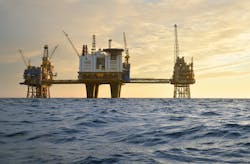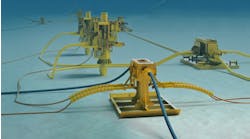Offshore staff
STAVANGER, Norway – Equinor has submitted an amended plan for development and operation (PDO) for the Oseberg field in the North Sea to Norway’s Minister of Petroleum and Energy (MPE).
This will involve converting Oseberg from primarily an oil production complex to a gas producer, and adding two new compressors at the field center to boost recoverable gas volumes.
In addition, the field center and the Oseberg South platform will be partially electrified to cut annual emissions from the field by 320,000 metric tons (352,740 tons). The reconstruction program will take four years to complete, with the modified complex starting service in 2026.
Three modules with a total weight of 3,400 metric tons (3,748 tons) will be installed on the platforms.
Oseberg was originally expected to produce around 1 Bbbl of oil, but the new target is close to 3.2 Bbbl, making this Norway’s third largest producing field.
Although oil production is now in the tail-end phase, 60% of the gas is yet to be recovered, and only Troll and Snøhvit have more remaining gas resources on the Norwegian continental shelf, Equinor said.
“We expect Oseberg to produce more than 100 bcm of gas towards 2040,” said Geir Sørtveit, Equinor’s svp for exploration and production west.
Since 2010, Equinor has introduced measures to reduce the field’s emissions by around 15%, and the target is a further 50-70% reduction by 2030.
With the switch to power from shore, the field’s total power demand will be up to 105 MW, and the preparations will also take into account full electrification of the installations in the future.
Aibel has the NOK4-billion plus ($443 million) EPCI contract for partial electrification of the field center and Oseberg South, and upgrading of the gas processing capacity on the field center.
The company will fabricate three modules at its yard in Haugesund, and perform most of the engineering and management at its offices in Bergen, Stavanger, and Oslo.
Nexans has a framework agreement with Equinor to supply subsea power cables. Its first assignment will be a 132-km (82-mi) cable for Oseberg, fabricated in Halden and installed by the new cable-lay vessel Nexans Aurora in 2023.
The value of this work is more than NOK800 million ($88.7 million).
Heerema Marine Contractors will perform transport and installation, with the crane vessel Sleipnir due to lift into place the three modules that Aibel is building during the summer of 2024.
Skanska Norge will construct the substation, cable trenches and landfall at Kollsnes under a co-operation with the Troll West electrification project.
Other partners in the license are Petoro, TotalEnergies EP Norge, and ConocoPhillips Skandinavia.
11/26/2021



